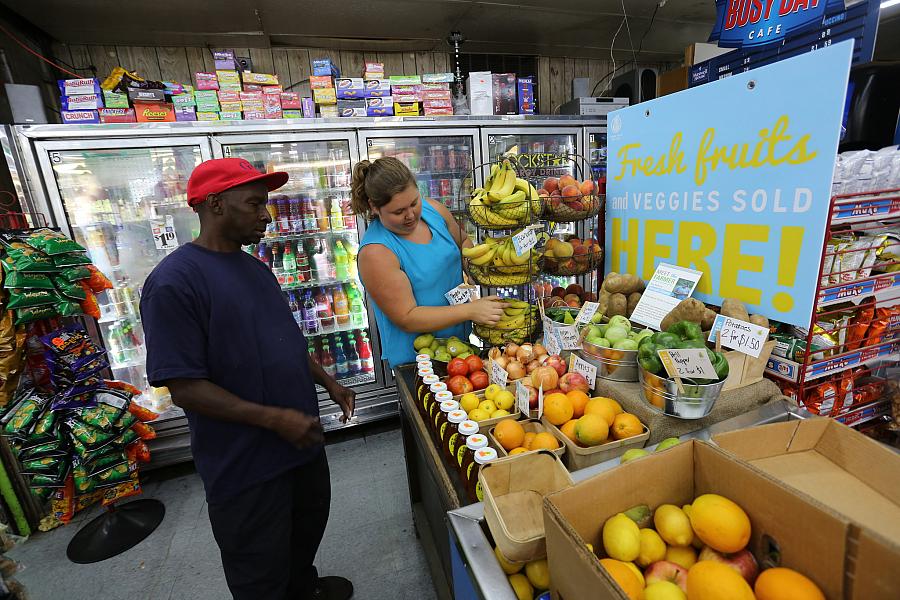Little stores, big stories: How to tell the story of healthier foods in small markets

A small market gets an infusion of fresh veggies.
This year, the second-largest discount chain in the country, Target, announced a plan to deemphasize processed foods and sell more healthy items, like granola and yogurt. Target is already testing out expanded grocery sections and junk-food-free checkout aisles. The new approach is part of a larger corporate shift toward promoting health. Consumers are increasingly seeking out healthy options, and retailers see an opportunity to meet growing demand.
But these changes may not do enough for low-income communities and communities of color, which often lack access to healthy, affordable foods and bear the burden of diet-related chronic disease. Discount stores, such as Target, and full-scale supermarkets aren’t always accessible. In many areas, small retailers are residents’ primary shopping outlets, so the foods those stores sell – or don’t sell – can affect the health of entire communities.
The media often focuses on national corporations, such as Target, CVS, and Walmart, that have taken steps to offer healthier products. But the work being done to improve small stores – outlets that often affect the health of already underserved populations – provides a rich opportunity for reporters to tell local stories. As advocates and retailers work to make small stores healthier places to shop, reporters can shed light on the importance of small stores in the movement to increase access to healthy foods.
The role of small stores
There are nearly 153,000 convenience stores in the country, more than the combined number of drug stores, supermarkets, supercenters, and dollar stores. Small stores – convenience, corner, and mom-and-pop stores – crop up everywhere, even in food deserts.
“Many people, especially in areas where transportation is an issue, can get a ride to the grocery store once or twice a month,” said Melissa Hallenbeck, a health educator working on the Eat Fresh, Live Well Healthy Corner Store Initiative in Toledo, Ohio. “The rest of the time, they shop at small stores because it’s more convenient.”
Advocates working to improve access to healthy, affordable foods have found an ally in small stores. Small retailers are recognizing they can attract and retain business by providing healthy items, especially in areas with the fewest healthy food retail outlets and the worst health outcomes.
Eat Fresh, Live Well, for instance, works directly with small stores to provide and promote fresh produce. In the first year of the initiative, produce sales from WIC vouchers doubled for participating stores. Storeowners reported a good return on investment, and residents are buying the new offerings.
A similar project, Shop Healthy NYC, works to improve bodegas in low-income areas of New York City. In a survey conducted by the New York City Department of Health, 59 percent of participating storeowners reported increased sales of healthier foods, and 42 percent reported increased overall profit. Notably, 46 percent of storeowners reported no change in profit, which suggests selling healthy foods may be less financially risky than many retailers believe. Forty-nine percent of customers surveyed said they bought a healthy item after seeing it promoted.
Reporting on local efforts
Small stores can improve the retail environment in a big way. Reporters can further the conversation around food access and retail solutions by highlighting local work and uncovering opportunities to effect change.
Change the frame: Residents, law enforcement, and government sometimes see small markets as intractable community blemishes, sources of blight, crime, and unhealthy products. These attitudes can undermine collaboration and exacerbate health inequities, especially in low-income areas and communities of color. Corner stores don’t have to be barriers to good health — under the right circumstances, they can be major partners in improving the retail environment. Reporters can look at the roles of small shops in their community. How do people view small stores? When and why do residents shop at these retailers?
Highlight problems and solutions: Creating equitable access to healthy foods requires a complex set of solutions. Reporters can zero in on the problems healthy retail advocates are addressing – lack of access to healthy, affordable foods or an excess of unhealthy items, for instance – the strategies they’re using, and the outcomes. When shoppers demand healthier foods, or local retailers change the way they stock their shelves, there are often great stories to tell. What’s working and what’s not, as shopkeepers introduce new products and methods of display?
Make connections: It’s important to tie local efforts to broader issues. Reporters can link healthy retail work to diet-related public health problems. “Lucas County has a high obesity rate and some of the worst health outcomes in Ohio,” said Tony Maziarz, project director of the Creating Healthy Communities Program that oversees Eat Fresh, Live Well. “Fortunately, Toledo has a corner store on almost every street corner. We realized those stores could help bridge the gap and provide access to good food.”
Look beyond the corner store: Food access means more than increasing the supply of healthy, affordable food. It also requires increasing demand for healthy items. Customers may need help shifting their buying and eating patterns – that could mean community cooking and nutrition classes, and other outreach efforts. Reporters can ask consumers about their shopping patterns and what’s driving their food choices. They can also identify other community programs that are working with corner stores to help change behaviors.
As big stores respond to consumers’ changing tastes, small stores are experimenting with healthy strategies in places where big stores may not exist. Reporters can call attention to what small stores are doing to create a supportive, healthy retail environment, and how they are overcoming challenges along the way.
Rio Holaday is a senior policy analyst at ChangeLab Solutions, where she focuses on food access and childhood obesity.
[Photo courtesy of ChangeLab Solutions.]

